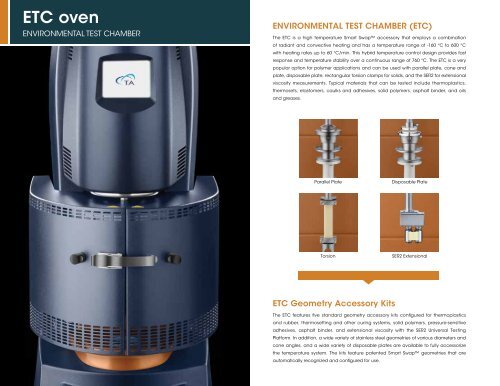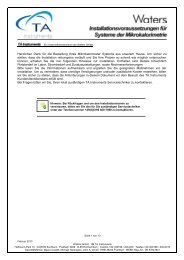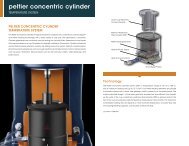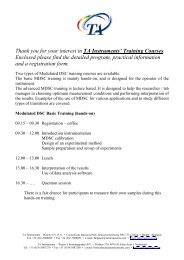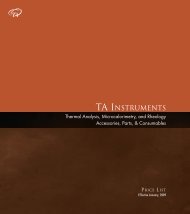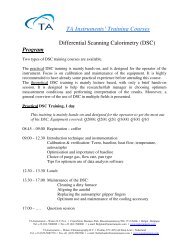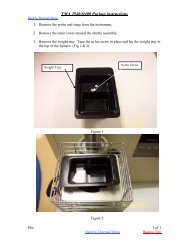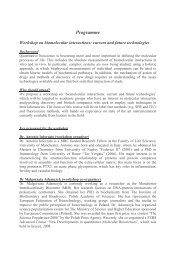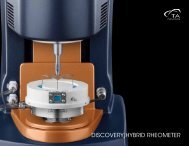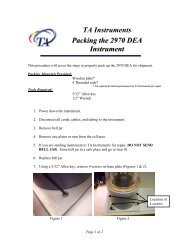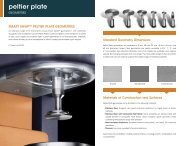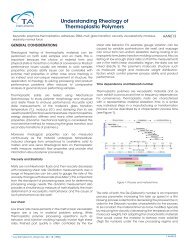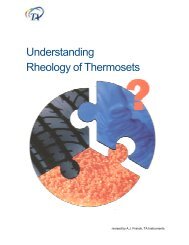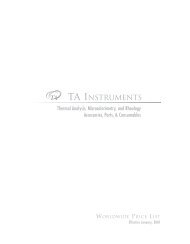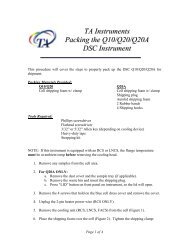ETC oven - TA Instruments
ETC oven - TA Instruments
ETC oven - TA Instruments
- No tags were found...
Create successful ePaper yourself
Turn your PDF publications into a flip-book with our unique Google optimized e-Paper software.
<strong>ETC</strong> <strong>oven</strong><br />
ENVIRONMEN<strong>TA</strong>L TEST CHAMBER<br />
Environmental Test Chamber (<strong>ETC</strong>)<br />
The <strong>ETC</strong> is a high temperature Smart Swap accessory that employs a combination<br />
of radiant and convective heating and has a temperature range of -160 °C to 600 °C<br />
with heating rates up to 60 °C/min. This hybrid temperature control design provides fast<br />
response and temperature stability over a continuous range of 760 °C. The <strong>ETC</strong> is a very<br />
popular option for polymer applications and can be used with parallel plate, cone and<br />
plate, disposable plate, rectangular torsion clamps for solids, and the SER2 for extensional<br />
viscosity measurements. Typical materials that can be tested include thermoplastics,<br />
thermosets, elastomers, caulks and adhesives, solid polymers, asphalt binder, and oils<br />
and greases.<br />
Parallel Plate<br />
Disposable Plate<br />
Torsion<br />
SER2 Extensional<br />
<strong>ETC</strong> Geometry Accessory Kits<br />
The <strong>ETC</strong> features five standard geometry accessory kits configured for thermoplastics<br />
and rubber, thermosetting and other curing systems, solid polymers, pressure-sensitive<br />
adhesives, asphalt binder, and extensional viscosity with the SER2 Universal Testing<br />
Platform. In addition, a wide variety of stainless steel geometries of various diameters and<br />
cone angles, and a wide variety of disposable plates are available to fully accessorize<br />
the temperature system. The kits feature patented Smart Swap geometries that are<br />
automatically recognized and configured for use.<br />
24
Oven Thermocouple<br />
Purge Ring<br />
Upper Geometry<br />
Handle<br />
Plate PRT<br />
Oven Clasp<br />
Ceramic Insulation<br />
Lower Geometry<br />
Mounting Bracket<br />
Heating Elements<br />
Camera<br />
Ceramic Insulation<br />
Secondary Illumination<br />
Features and Benefits<br />
• Unique Smart Swap technology<br />
• No extra electronic boxes<br />
• Combined convection and radiant heating design<br />
• Wide temperature range: -160 °C to 600 °C<br />
• Maximum heating rate of 60 °C/min<br />
• Liquid nitrogen option connects directly to bulk source<br />
• Wide variety of stainless steel plates, cones, crosshatched,<br />
and disposable geometries<br />
• Optional built-in camera viewer<br />
• Melt rings for thermoplastic pellet samples<br />
• Die punch for molded plaques<br />
• Sample cleaning and trimming tools<br />
• Extensional rheology measurements with SER2 Universal<br />
Testing Platform<br />
<strong>ETC</strong> Technology<br />
The Smart Swap <strong>ETC</strong> is a “clam-shell” design. Each half of the <strong>oven</strong> contains an electric radiant heating element surrounded by a ceramic insulation block. Air or nitrogen gas is introduced through a purge<br />
ring with the gas flow directed over the heated coils, providing heat transfer by convection. For subambient testing, both gas and liquid nitrogen are fed through the purge ring. Liquid nitrogen usage is kept<br />
to a minimum by switching from gas to liquid nitrogen only when cooling is required. Temperature sensors are used both in the <strong>oven</strong> and below the lower plates for temperature measurement and control.<br />
The <strong>ETC</strong> also features a camera viewer option installed through the chamber’s right-side ceramic block. The camera option features multiple light sources, remote focusing, and can be used over the entire<br />
temperature range. Used in conjunction with the streaming video and image capture software, real-time images can be displayed in the software and an image is stored with each data point for subsequent<br />
viewing. The <strong>ETC</strong> camera viewer is an ideal tool for data validation.<br />
<strong>ETC</strong> Oven<br />
25
<strong>ETC</strong> and EHP<br />
POLYMER APPLICATIONS<br />
Polystyrene Frequency Sweeps from 160 ˚C to 220 ˚C<br />
1.0E6<br />
Extended Frequency Range with TTS<br />
1.0E6<br />
1.0E5<br />
Reference Temperature = 210 ˚C<br />
1.0E5<br />
Themoplastic Polymer Rheology Using Parallel Plate<br />
Parallel Plate geometries are most popular for testing of thermoplastic polymer melts. An example of<br />
polystyrene characterized over a temperature range of 160 °C to 220 °C is shown in the figure to the<br />
10000<br />
10000<br />
left. Frequency sweeps were run at multiple temperatures over an experimental range of 0.06 to 628<br />
G’ (Pa)<br />
G” (Pa)<br />
rad/s. The magnitude of the viscoelastic properties, storage modulus (G’) and loss modulus (G”),<br />
for the individual sweeps can be seen to decrease with increasing temperature over this frequency<br />
1000<br />
1000<br />
range. Since polymer melts are viscoelastic, their mechanical response will be time dependent, so low<br />
frequency corresponds to long time behavior. Time Temperature Superposition (TTS) is used to widen the<br />
range of data to higher and lower frequencies and generate a Master curve at a reference temperature<br />
100.0<br />
Experimental<br />
Frequency Range<br />
100.0<br />
pertinent to the application. The polymer’s molecular structure dictates the magnitude and shape of<br />
the G’ and G” curves.<br />
10.0<br />
0.010 0.10 1.00 10.0 100.0 1000 10000<br />
10.0<br />
1.0E5<br />
ω (rad/s)<br />
1.0E7<br />
B-Stage Prepreg Temperature Ramp and Hold Cure<br />
Isothermal Step<br />
200.0<br />
Themoset Cure Using Disposable Plate Kit<br />
|η*| (Pa.s)<br />
1.0E6<br />
1.0E5<br />
Temperature<br />
Ramp Step<br />
Softening<br />
Minimum<br />
Viscosity<br />
175.0<br />
150.0<br />
125.0<br />
100.0<br />
10000<br />
25.0<br />
0 20.0 40.0 60.0 80.0 100.0 120.0<br />
time (min)<br />
Curing<br />
Reaction<br />
Final Cure<br />
75.0<br />
50.0<br />
Temperatrure (˚C)<br />
Changes in the viscoelastic properties of reactive systems provide valuable information about their<br />
processing and end-use properties. Often these materials can start in the form of a low viscosity liquid,<br />
a paste, or even a powder, and after reacting end as a high modulus solid. If the material hardens<br />
and adheres to the testing surface, low-cost disposable parallel plates are required for testing. The<br />
figure to the left shows the complex viscosity from a typical oscillatory temperature ramp and hold<br />
curing test conducted, on a B-stage prepreg using 25 mm diameter disposable plates. The resin is<br />
impregnated on a w<strong>oven</strong> glass matrix, which becomes part of the permanent high strength composite<br />
structure once the resin is cured. Upon heating, the resin softens until reaching a minimum viscosity,<br />
which is a very important processing parameter. If the viscosity is too high or too low, the resin will not<br />
flow or coat the matrix uniformly leaving voids, creating flaws in the composite. Eventually the viscosity<br />
starts building and the curing reaction takes off dramatically. The temperature is held constant at the<br />
processing temperature and the viscosity is monitored until the viscosity reaches a plateau indicating<br />
the completion of the reaction.<br />
26
ABS Oscillation Temperature Ramp in Torsion Rectangular<br />
1.0E10<br />
10.00 1.0E10<br />
1.0E9<br />
Styrene<br />
Tg = 114 ˚C<br />
1.000<br />
1.0E9<br />
Solid Polymer Rheology Using Torsion<br />
Rectangular Clamps<br />
G’ (Pa)<br />
1.0E8<br />
1.0E7<br />
tan(delta)<br />
0.1000<br />
1.0E8<br />
1.0E7<br />
G”(Pa)<br />
The <strong>ETC</strong> <strong>oven</strong> has the ability to characterize the viscoelastic properties of rectangular solid samples up<br />
to 5 mm thick, 13 mm wide, and 50 mm long. The figure to the left shows an example of an oscillatory<br />
temperature scan on a solid ABS specimen run at 3 °C/min from -160 °C to 200 °C. The ABS is a copolymer<br />
that exhibits two glass transition temperatures: one at -81 °C associated with the Butadiene and one at<br />
114 °C associated with Styrene. Transitions, or relaxations of molecular segments, are observed as step<br />
1.0E6<br />
Butadiene<br />
Tg = -81.2 ˚C<br />
0.01000<br />
1.0E6<br />
changes in the storage modulus (G’) and as peaks in the loss modulus (G”) and damping (tanδ). The<br />
magnitude and shape of these parameters will depend on chemical composition as well as physical<br />
characteristics (such as crystallinity, orientation, fillers, and degree of cross-linking).<br />
1.0E5<br />
Frequency: 6.28 rad/s<br />
Ramp Rate: 3 ˚C/min<br />
1.000E-3<br />
-200.0 -150.0 -100.0 -50.0 0 50.0 100.0 150.0 200.0<br />
Temperature (˚C)<br />
1.0E5<br />
SER2 compared to shear viscosity data<br />
1.0E6<br />
LDPE 1810H<br />
T=150 ˚C<br />
Extensional Viscosity measurements with the<br />
SER2 attachment<br />
Viscosity η E<br />
(Pa.s)<br />
1.0E5<br />
10000<br />
3x shear viscosity<br />
Elongation rate (s -1 )<br />
0.02<br />
0.1<br />
0.3<br />
1.0<br />
3.0<br />
The <strong>ETC</strong> is designed to accommodate the SER2 (Sentmanat Extension Rheometer) for extensional<br />
viscosity measurements of polymer melts. In the figure to the left, data are plotted for extensional viscosity<br />
measurements of standard LDPE 1810H at 150 ˚C at extensional rates from 0.02 to 3 s -1 using the SER2.<br />
These results are compared to three times the corresponding low shear rate viscosity, which agrees well<br />
with the zero rate extensional viscosity prior to the onset of extensional thickening at different extension<br />
rates. In addition to extensional viscosity, the SER2 can also be used for solids tensile testing, tear testing,<br />
peel testing, friction testing, as well as high-rate fracture testing.<br />
1000<br />
0.01 0.1 1 10 100 1000<br />
time (s)<br />
EHP and <strong>ETC</strong> Polymer Applications<br />
27
dielectric measurement<br />
ACCESSORY<br />
BNC Connections<br />
to LCR Meter<br />
Wire to Upper Plate<br />
Dielectric Accessory<br />
The Dielectric Accessory, available for all DHR models, extends material characterization<br />
capabilities by providing an additional technique similar to dynamic mechanical. In dielectric<br />
analysis, an oscillation electrical field (AC Field) is used as opposed to mechanical force<br />
(stress) and the oscillating strain is a stored charge (Q) in the sample. The technique measures<br />
the degree to which the sample is storing a charge (capacitance) or passing a charge<br />
(conductance) through its bulk. The DHR provides a flexible platform for easy test setup and<br />
calibration, and data accuracy through standard features such as the Environmental Test<br />
Chamber, axial force control, and gap temperature compensation routines. Dielectric analysis is<br />
a very powerful technique for characterizing polar materials such as PVC, PVDF, PMMA, and PVA,<br />
for phase separating systems, and for monitoring curing kinetics of materials such as epoxy and<br />
urethane systems. Dielectric analysis extends the measurable frequency range over traditional<br />
dynamic mechanical analysis which is typically limited to 100 Hz.<br />
Ground Geometry with<br />
Ceramic Insulation<br />
Smart Swap<br />
Connection<br />
Wire to Lower Plate<br />
BNC Connections<br />
to LCR Meter<br />
Dielectric<br />
Accessory<br />
Mount<br />
Technology<br />
The Dielectric accessory consists of a special set of 25 mm parallel plates that are fitted with<br />
wiring and hardware for interfacing with a dielectric LCR meter (Agilent Model E4980A LCR)<br />
that imposes a signal at a certain voltage and frequency/ies. The voltage range available<br />
is between 0.005 to 20 V with a frequency range of 20 Hz to 2 MHz. The Environmental Test<br />
Chamber (see page 24) provides temperature control at a range of -160 °C to 350 °C. The<br />
accessory allows for the simultaneous collection of rheological and dielectric information,<br />
or dielectric measurements can be run independently.<br />
Features and Benefits<br />
• Smart Swap technology<br />
• 25 mm diameter plates with ceramic insulation<br />
• Disposable plates for curing system<br />
• Stand-alone dielectric measurements<br />
• Combined rheological and dielectric measurements<br />
• Fully programmable from TRIOS Software<br />
• Time-Temperature Superposition<br />
• Master curve generation<br />
• Wide dielectric frequency range: 20 Hz to 2 MHz<br />
• Easy installation and removal<br />
• Compatible with <strong>ETC</strong> over a temperature range of -160 °C to 350 °C<br />
• USB Interface<br />
28
Simultaneous Dielectric and Rheology of Hand Creams on Freezing<br />
Storage modulus (Pa)<br />
10 8<br />
10 7<br />
10 6<br />
10 5<br />
10 4<br />
10 3 -40 -30 -20 -10 0 10 20 30<br />
10 -1<br />
Temperature (˚C)<br />
POND’S cream<br />
NIVEA cream<br />
Cooling rate: 3 ˚C/min<br />
Mechanical Frequency: 1 Hz<br />
Dielectric Frequency: 200 Hz<br />
10 7<br />
10 6<br />
10 5<br />
10 4<br />
10 3<br />
10 2<br />
10 1<br />
10 0<br />
Loss permittivity ε” (pF/m)<br />
Phase Separation in Cosmetic Creams<br />
Temperature stability of materials such as food and cosmetics is very important for product performance<br />
in storage and transportation. Rheological testing is widely used for stability evaluations; however, the<br />
ability to simultaneously measure dielectric properties can provide more valuable insight for complex<br />
formulations. An example is shown in the figure to the left for two water-based cosmetic creams<br />
tested by cooling from 25 °C down to -30 °C. In comparing only storage modulus, G’, data of the two<br />
materials, the POND’S ® cream shows little increase followed by a three decade jump at -18 °C, but<br />
NIVEA cream exhibits a more continuous change in the modulus over the entire temperature range.<br />
One may conclude from the mechanical response alone that the large jump in G’ of POND’S at -18 °C<br />
is associated with instability. However, having the simultaneous measurement of the loss permittivity, ε”,<br />
provides information relating to the change in ion mobility; primarily of the water phase in these samples.<br />
In the ε” the NIVEA shows a two decade jump compared to very little change in the ε” of the POND’S.<br />
The large increase in ε” is due to increased ion mobility in the material as the water separates. In the final<br />
analysis, phase separation occurs in the NIVEA, not the POND’S. During the cooling process, as phase<br />
separation gradually occurs, the water phase grows changing the morphology. As the morphology<br />
gradually changes, so too does the G’. The large change in G’ of the POND’S is the result of a transition<br />
of a more stable and uniform morphology.<br />
30.0<br />
Dielectric Temperature Ramp on PMMA<br />
ε’<br />
0.175<br />
0.15<br />
Storage permittivity ε’ (pF/m)<br />
15.0<br />
0<br />
-15.0<br />
1000 Hz<br />
10000 Hz<br />
100000 Hz<br />
1000000 Hz<br />
tan δ<br />
0.125<br />
0.1<br />
0.075<br />
0.05<br />
tan (δ)<br />
Dielectric Temperature Ramp<br />
at Multiple Frequencies<br />
The figure to the left shows a temperature ramp on a Poly (methyl methacralyte), PMMA, sample at<br />
four different dielectric frequencies ranging from 1,000 Hz to 1,000,000 Hz. It can be seen here that the<br />
magnitude of ε’ decreases with increasing frequency through the transition region and the peak of the<br />
transition in tan d moves to higher temperatures with increasing frequency.<br />
0.025<br />
-30.0<br />
0<br />
25 50 75 100 125 150 175 200 225<br />
Temperature (˚C)<br />
section Dielectric title 29


